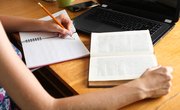Many students are introduced to report writing and research in middle school. Though each school will require different report components, the Common Core State Standards, a national set of standards that were developed by a consortium of states, set some specific goals that middle school students should meet by the time they move to high school, from generating questions to editing their work.
Answer a self-generated question
Middle school students should move toward independence in determining their own thoughts about a subject, as opposed to summarizing the ideas of others or answering a teacher-generated question. For example, an English teacher might ask a middle school student to write a report that analyzes characters in a story. A student might narrow the assignment and form a thesis that considers which character had the greatest impact on the plot of the story.
Generate an opinionated central point
Every report needs to have a central point, known as a thesis, claim or topic. A middle school student should be able to articulate their main point in any report, both in written and oral form. This main point must contain a perspective and not be simply a statement of fact. For example, a middle school history student might have to offer their opinion on which 20th century war was most significant. A thesis could be: "World War II was the most significant 20th century war because it enabled the rise of the two superpowers from the Cold War, the Soviet Union and the United States."
Use evidence to support the central point
Most teachers will suggest that middle school students use at least three reasons to prove their central point, with specific evidence to back up the perspective. This evidence could be based on research or personal observations, such as an experiment done in science class. For example, evidence to support the history thesis mentioned earlier could include the shift of power that occurred during World War II, a discussion of the partitioning of Germany after the war, and a review of the events of the Cold War. A student could use their history textbook and primary source documents as sources.
Cite sources to avoid plagiarism
Middle school students should avoid plagiarism by citing sources throughout their report. This should include paraphrasing, summarizing and using textual examples. Many students understand that it is wrong to steal someone's work, but do not understand every situation that is considered plagiarism. For example, some believe they can include a list of sources without indicating which parts of their essay came from those sources. Parents and teachers should check with students to make sure they understand what plagiarism is.
Conduct thorough revision
Reports should be edited several times before they are submitted to a teacher for critique. The Common Core State Standards suggest self, peer and adult editing before a report is graded. Editors should focus on determining if the question has been answered, the evidence is strong, sources have been correctly cited and the student has followed the standard conventions of English grammar and spelling.
Related Articles
References
Resources
Writer Bio
Anna Tower has a B.A. in history and journalism from Washington & Lee University and a M.A.Ed. from the College of William and Mary. She has been writing since 2003 at various publications, including the "Rockbridge Report," the "Fairfax County Times" and "USA Today." Tower is certified to teach social studies, English and journalism in grades 6-12.











